Introduction
In the beginning of the 20th century a new idea has emerged that contradicted the scientific method and denied the objectivity or reality.
Key concepts:
- Ontology – explanation of reality;
- Epistemology – the theory of knowledge;
- Causal processes – theories of causality and change;
- Phenomenology – a study of the creation of what is taken to be real;
- Bracketing – disbelieving that the world is naturally ordered.
At the beginning of the 20th century, a new idea has emerged that contradicted the scientific method and denied the objectivity or reality. The idea supported the creation of many theories that emphasized the importance of cultural, situational, and socially constructed aspects of human experience. Today we are going to touch upon these theories in great detail. However, before we start, it is beneficial to make sure that everyone understands the terms that will be used during today’s presentation. Ontology is the branch of metaphysics dealing with the nature of being and explanation of reality.
Epistemology is the theory of knowledge, especially with regard to its methods, validity, and scope, and the distinction between justified belief and opinion.
Causal process is an idea that one process contributes to the production of another process.
Phenomenology is an approach that concentrates on the study of consciousness and the objects of direct experience.
— AND —-
Bracketing is setting aside the idea that the real world is naturally ordered.
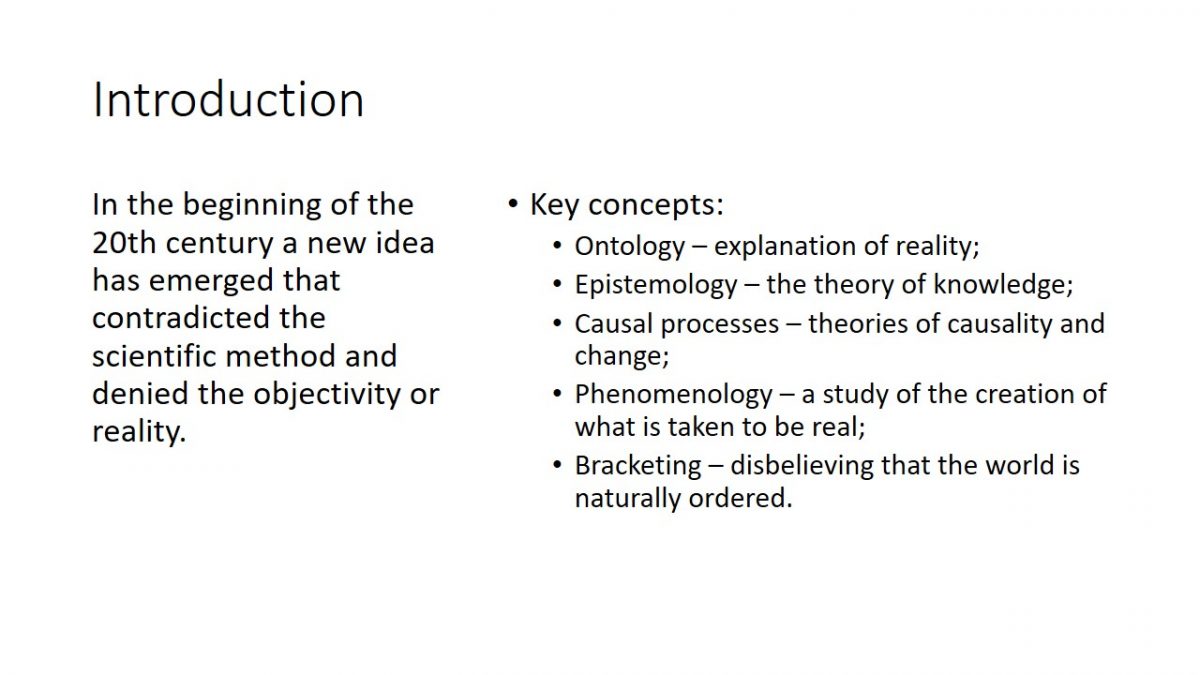
Overview
- Theories:
- Phenomenology:
- Transcendental Phenomenology;
- Phenomenology of Everyday Life;
- Social Constructionism;
- Hermeneutics;
- Phenomenology:
- Ethnomethodology.
- Post-Modernism.
- Theory Application.
Today we are going to discuss three theories or philosophies that prevailed in the middle and at the end of the 20th century. The theories are Phenomenology, which can be subdivided into Transcendental Phenomenology and Phenomenology of Everyday Life, Social Constructionism, and Hermeneutics. These theories had a lot in common; however, there were differences in some crucial points concerning the dualism of objective and subjective and the concept of self.
We will also discuss Ethnomethodology, which is an applied method of phenomenology. We will also briefly touch upon postmodernism, which is a collective name for all the theorists of the late 1900s.
Finally, we will discuss how these theories can be applied to social work and my research question.
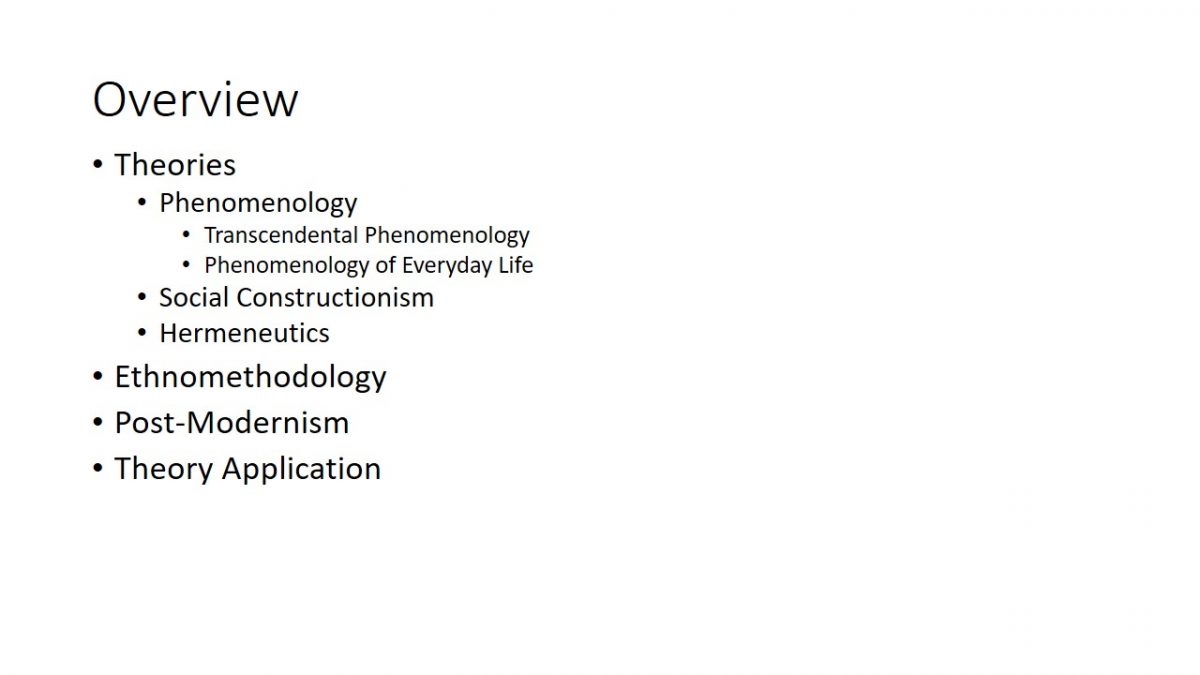
Transcendental Phenomenology
- Founder: Edmund Husserl.
- Year: 1936.
- He noted “surreptitious substitution of the mathematically substructed world of idealities for the only real world” (Robbins, Chatterjee, & Canda, 2012).
At the beginning of the 20th century, Positivism was a trending philosophy that was utilized by the majority o scientists. It emphasized that the reality is singular, knowledge is authorized as valid by logic or reason, and learning is a linear process based on cause and effect. However, there were anti-positivists who had contrasting views on ontology, epistemology, and causal processes.
In 1934, Edmund Husserl published a book called “The Crisis of European Sciences and Transcendental Phenomenology.” In this book, he noted surreptitious substitution of the mathematically substructed world of idealities for the only real world. The book claimed that every person’s reality is individual, knowledge is behavioral and emotional as well as cognitive, and learning and development involve refinements and transformation of mental representations. The book has given rise to many theories, which emerged later in the 20th century.
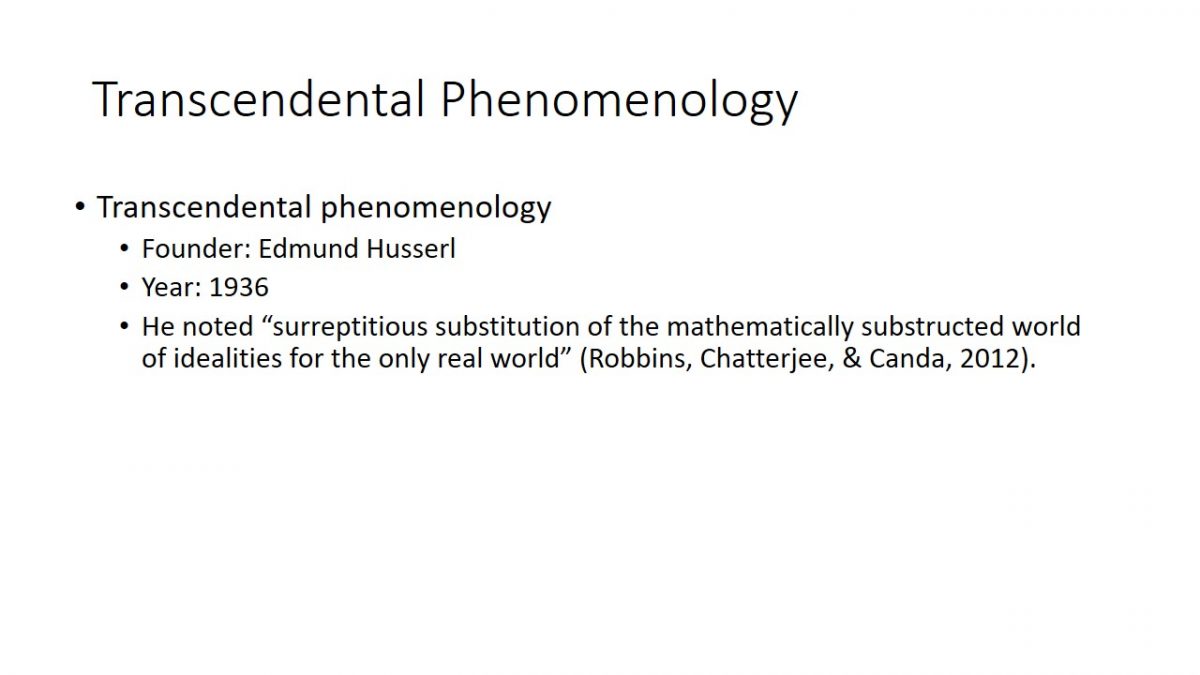
Phenomenology of Everyday Life
- Formulated by Alfred Schutz in 1967;
- Opposed Weber’s dualistic viewpoint;
- Distinguished between first-order processes and second-order processes;
- Intersubjective manner of phenomenology;
- “We-relations” and “they-relations”;
- Underlined typification.
Husserl’s follower, Alfred Shutz, developed the idea of transcendental phenomenology. Shutz elaborated a theory which was called “Phenomenology of Everyday Life.” The theory opposed Weber’s dualistic viewpoint and claimed that humans could not percept objective reality.
Schutz distinguished between first-order processes by which we interpret our own and others’ actions in everyday life and second-order processes by which a social scientist seeks to understand the first-order processes. Second-order processes are interpretations that take place to a great extent in terms of the first-order categories by which we make sense out of ordinary life.
Such views led to the idea that phenomenology is not transcendental, but rather social or intersubjective. People share experiences through face-to-face communication of “we-relations.” At the same time, people can interact with impersonal contemporaries, which is seen as “they-relations.” Through such interactions, people acquire typifications, which are constructs, or recipes, that we gain through socialization that help us use typical actions for typical situations in daily life.
Shutz’s ideas are believed to be overly complicated. This has led to many interpretations.
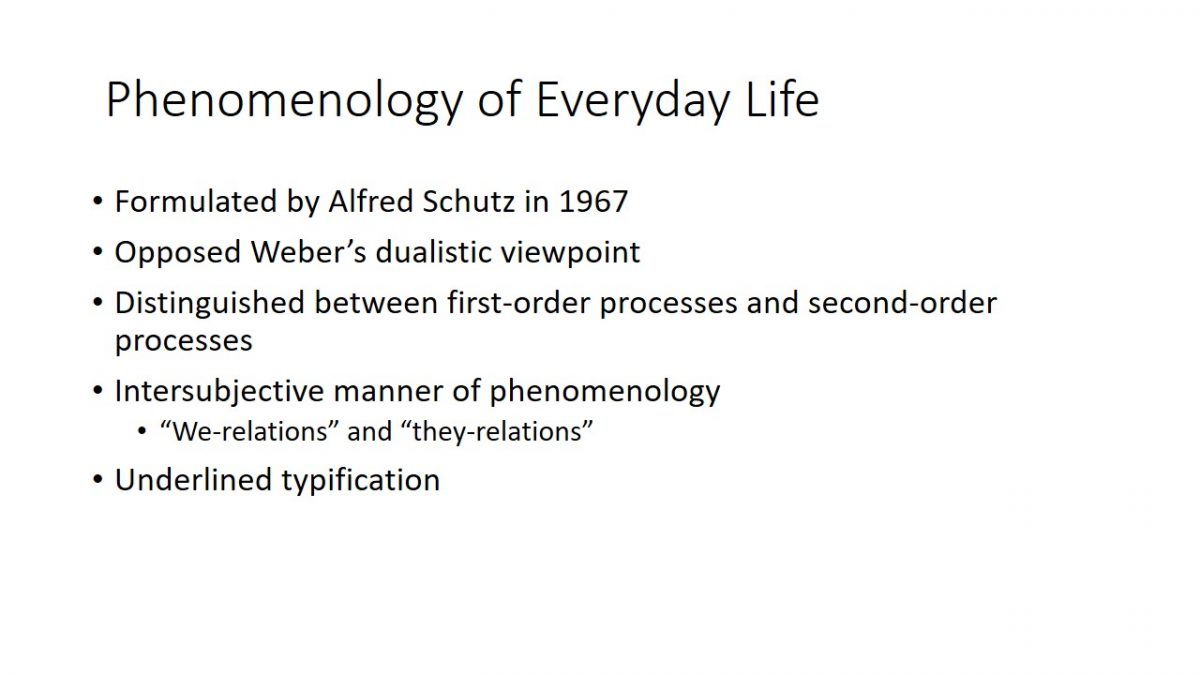
Ethnomethodology
- Ethnomethodology was introduced by Harold Garfinkle in 1967.
- Considered micro-phenomenology.
- Analysis of commonplace everyday activities in social settings.
- Phenomenology spread to the US though Garfinkle’s ideas.
Ethnomethodology is a concept coined by Harold Garfinkle in 1967. Inspired by Schutz, Garfinkle believed that research and theorizing are to be done in conjunction, such that the theorizing is tied to the materials generated by the research. He developed experiments aimed at disrupting the flow of normal events to demonstrate the fragility of social reality. For instance, he asked the students to act like they are guests while being at home. The reactions of family members demonstrated the importance of shared definitions and shared assumptions.
Garfinkle’s ethnomethodology is considered micro-phenomenology because it examines how everyday life situations are the products of our collective actions.
Today, ethnomethodology is viewed as an analysis of commonplace everyday activities in social settings. It was vital for spreading German thought to the West Coast of the US.
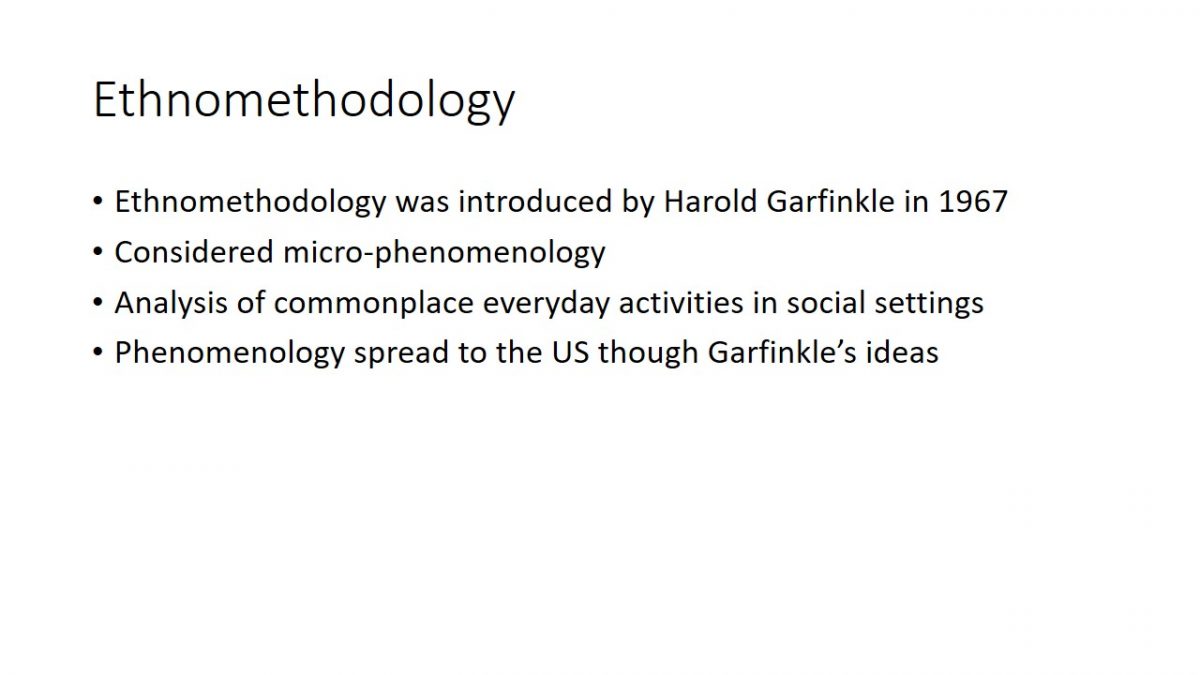
Concept of Self
- The self is viewed as a process;
- Intentionality of consciousness;
- Postmodernist phenomenology introduced by Dreyfus in 1987;
- Unchanging foundations of self shifted;
- No universal or trans-historical self, only local selves.
The concept of Self is of extreme importance to all theories and philosophies. In phenomenology, Self is viewed as a process in which the Self is the “originator of experience within a biographically determined situation. However, unlike symbolic interactionists, phenomenologists viewed Self as a conscious subject. Consciousness, at the same time, is viewed as an intentional process rather than involuntary.
During the last decades o the 20th century, many theorists have emerged, which were grouped and named postmodern. Even though there is no official founder of the post-modernistic thought, Dreyfus may be considered a founder since he introduced a postmodernist view on the concept of Self. He argued that there is no unchanged foundation of Self, and there is no universal or trans-historical self, only local selves. Cultural conceptualizations and configurations of Self are formed by the economies and politics of their respective eras.
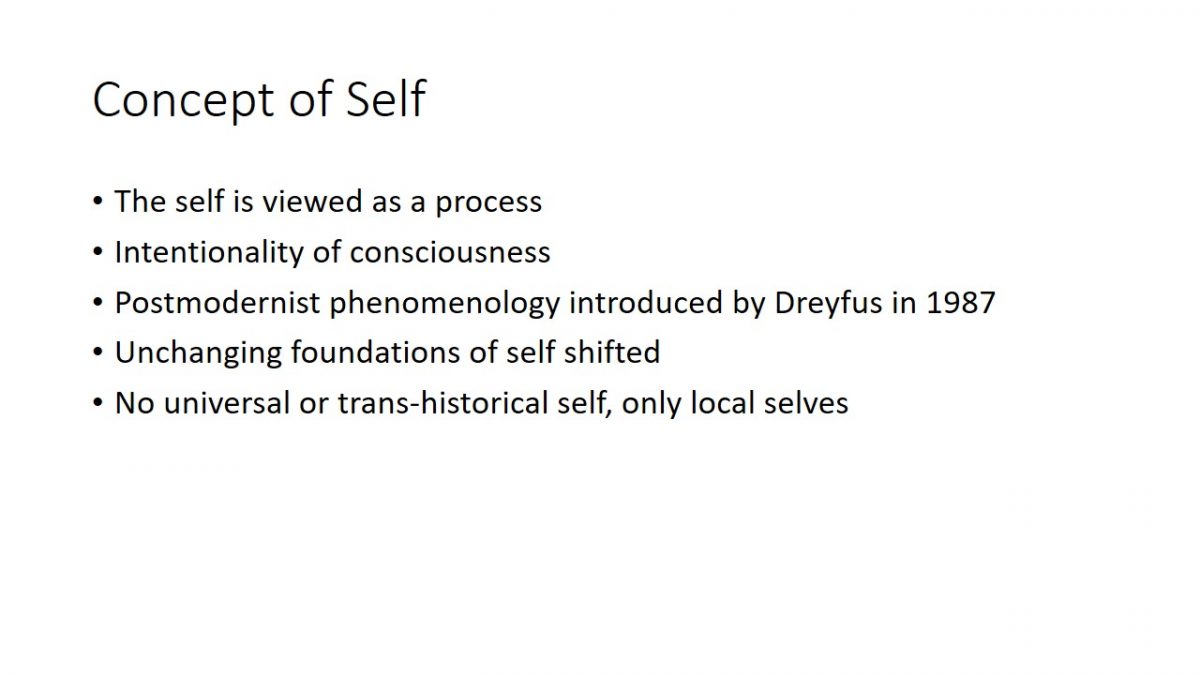
Social Constructionism
- Introduced by Peter Berger and Thomas Luckmann in 1967.
- People are the products of the very society they create.
- Dualism of objectivity and subjectivity.
- No criteria for truth.
- Michel Foucault stated that subjective truths are used for exercising power.
Social constructionism is another branch of Husserl’s transcendental phenomenology. It was formulated in 1967 by Peter Berger and Thomas Luckmann. They stated that humans create a society, and society creates people. People are born in a pre-existing society, and, as they grow, they continue to contract society. Unlike phenomenology of every day, Social Constructionism believed that society is objective, but there is no method for reaching objectivity. In other words, constructionists believed in the duality of objectivity and subjectivity. At the same time, they emphasized that people can operate only with subjective matters since they are forced to live by the rules the society has created.
Unlike Weber, Berger and Luckmann offered to criteria for truth. In fact, in post-modernistic developments of constructivists’ thought, Michel Foucault denied the existence of truth. Instead, the truths are multiple and are used to manipulate society and exercise power.
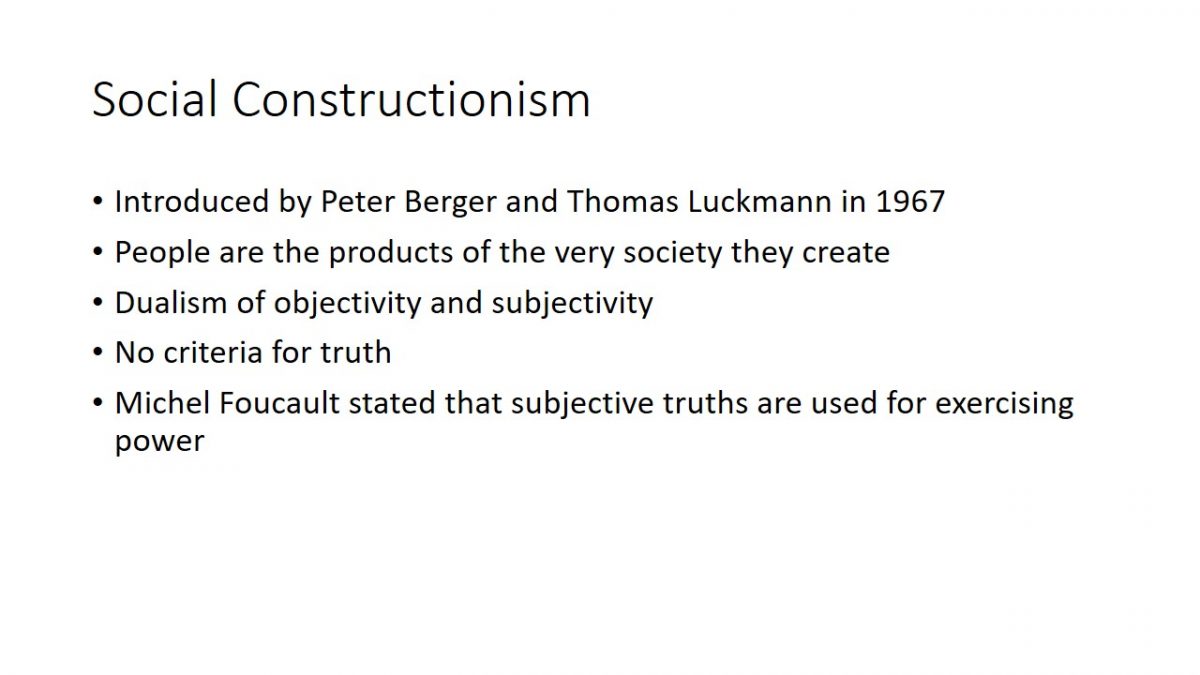
Hermeneutics
- Emerged at the end of 20th century.
- Study of understanding.
- Central concept: self-interpretation.
- Criticized detachment of self from society.
Hermeneutics emerged at the end of the 20th century. Even though there was no founder of the philosophy or the exact date of its formulation, it has become wide-spread in the 1990s. Initially, it was a philosophical movement that studied understanding. The philosophy identified the concept of Self as a constant process of interpretation. In other words, rather than being identified by others, people identify and interpret themselves influenced by the opinions of the others.
Hermeneutics criticized the stance of phenomenologists, social constructivists, and post-modernists, which supported sharp separateness and detachment of the individual Self that modern thought believes to be necessary for human freedom and moral autonomy. The followers of hermeneutics believed that such an attitude could lead to emotional isolation and emptiness.
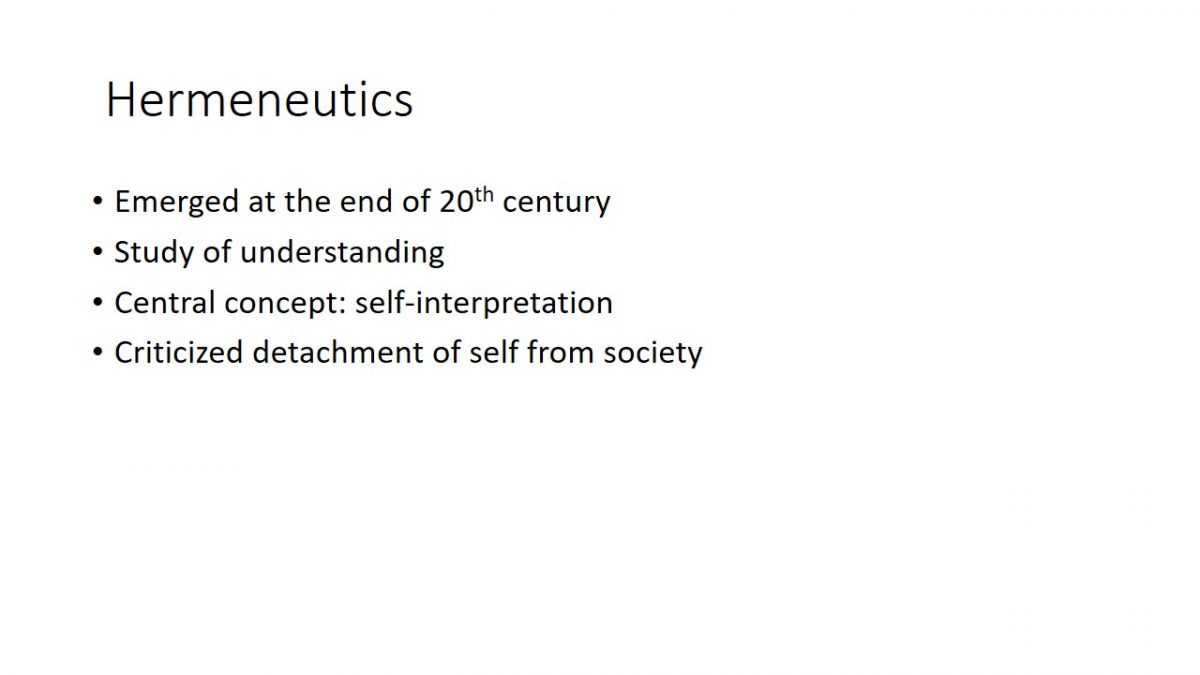
Application
- Narrative therapy:
- Deconstructive listening;
- Deconstructive questioning;
- Questioning assumptions and beliefs;
- Building on coping abilities and strengths;
- Externalizing the problem.
- Solution-focused therapy.
All three theories are extensively used for various therapies.
Narrative therapy emphasizes storytelling, followed by a series of purposeful questioning techniques, reflections, and probing aimed at introducing new ideas and elucidating parts of the client’s story not previously emphasized.
Some commonly used techniques in narrative practice include deconstructive listening (listening for other possible meanings); deconstructive questioning (to help clients see how stories are constructed); questioning assumptions and beliefs (to bring forth problematic beliefs, practices, feelings and attitudes); building on coping abilities and strengths; understanding internalized conversations (to help clients reframe their experiences into a positive light to find new stories that are more empowering to tell); externalizing the problem; and tracking influences.
Solution-focused therapy emphasizes the process and future behaviors that will help clients accomplish their goals. The primary focus is to help clients construct a set of behavioral tasks that lead to a rapid solution. Solution-focused therapists use a wide variety of methods to help clients achieve change.
The table presented on this slide can help to acquire a better appreciation when the theories can be used.Phenomenology, social constructionism, and Hermeneutics can be used in mental health centers and private practices for re-evaluating career goals. For this matter, narrative therapy and self-reflective journaling are used.
The approaches can be used for university-based mental health services to students anxious over coming out as gay. Personal beliefs about sexual orientation may be explored during individual counseling.
Family service centers can also benefit from the described frameworks in family therapy. A therapist can deconstruct family patterns and reconstruct new patterns to avoid conflict over family roles and rules.
City task force on cultural diversity can also use the theories for addressing racist stereotypes for anti-racist education programs.
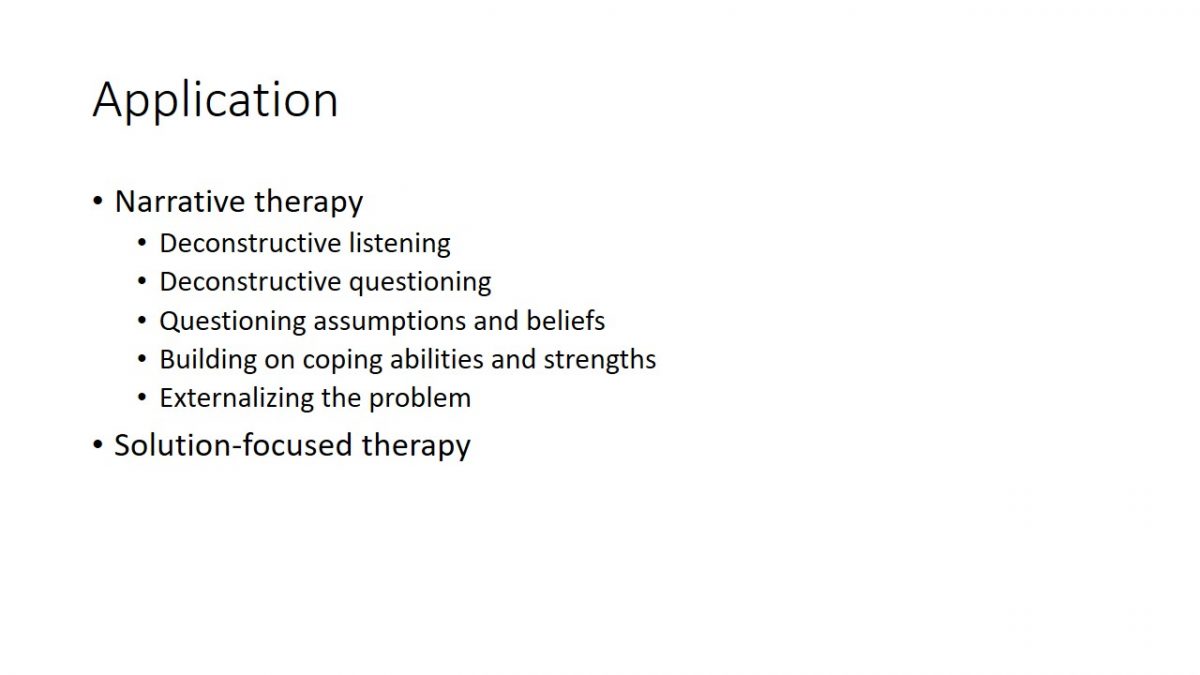
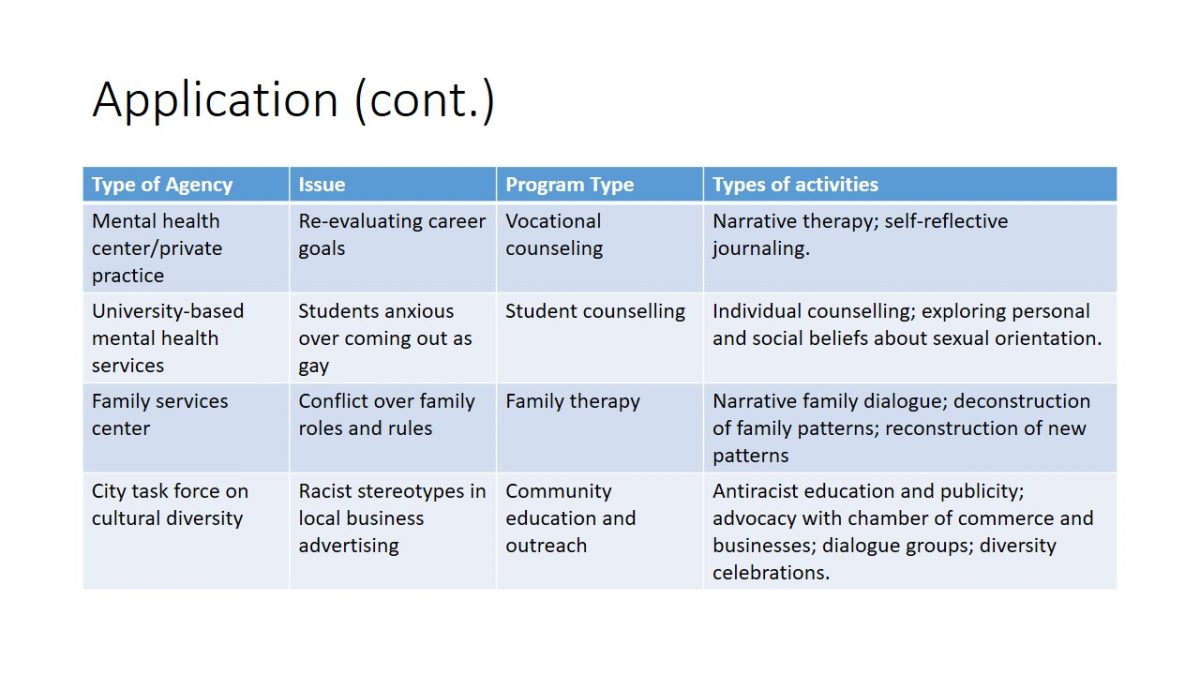
Application to the Issue of Interest
- Research question:
- “What is the lived experience of first-generation Latino service members, who remained in U.S.A. after transitioning?”
- All the reviewed theories can be applied to interpret the findings of my research question.
- Social constructionism and phenomenology can help to understand how a detached self helped to isolate form reality.
- Hermeneutics can help to identify how interaction with other people could help to construct new reality.
As you may remember from my previous presentations, my research question is: “What is the lived experience of first-generation Latino service members, who remained in the U.S.A. after transitioning?”
Since the discussed theories have a lot in common, all of them can be applied to interpret the findings of my research question.
Social constructionism and phenomenology can help to understand how a detached self helped to isolate from reality if veterans experience depression, isolation, and emptiness.
Hermeneutics can help to identify how interaction with other people could help to construct a new reality. The experience of the veterans can be deconstructed to understand what beliefs helped or obstructed them from being successful.
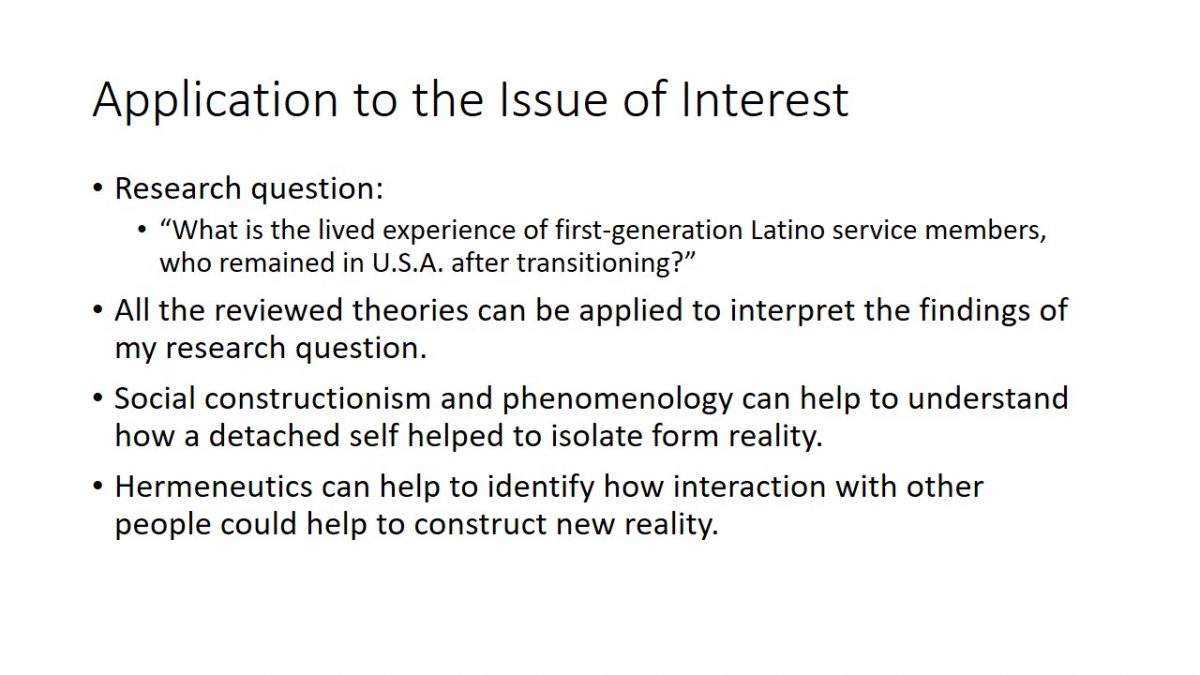
Conclusion
- Key concepts discussed.
- Theories overviewed.
- Applicability to social practice demonstrated.
- Relevance to research question identified.
Theories are vital for guiding studies and evaluating the research results. Today we discussed three key theories introduced in Chapter 11 of Contemporary human behavior theory, including phenomenology, social constructionism, and hermeneutics. All the theories are applicable to social work in vocational counseling, student counselling, family therapy, and community education and outreach. All the theories can be used for my research to interpret the findings.

References
Robbins, S., Chatterjee, P., & Canda, E. (2012). Contemporary human behavior theory(2nd ed.). New York, NY: Pearson.